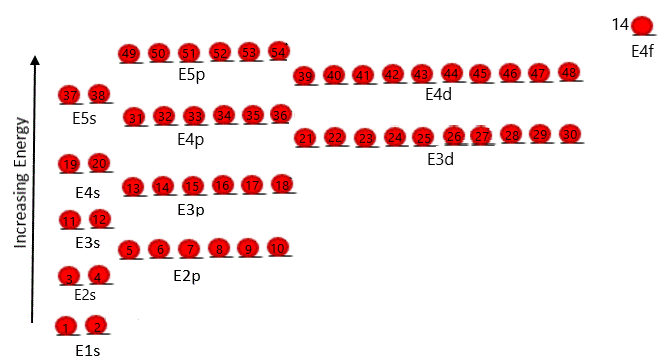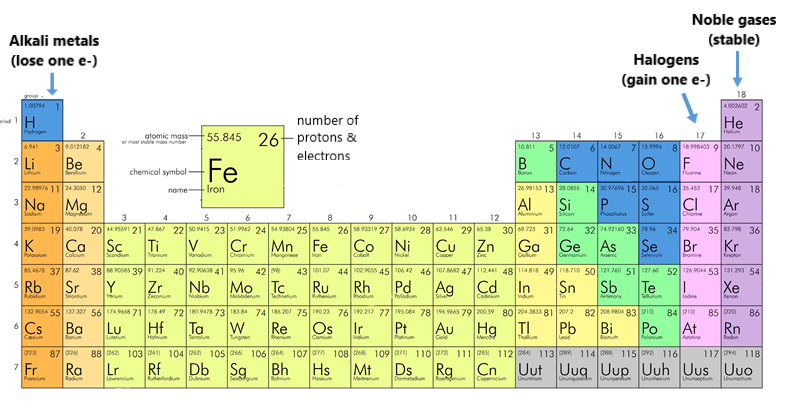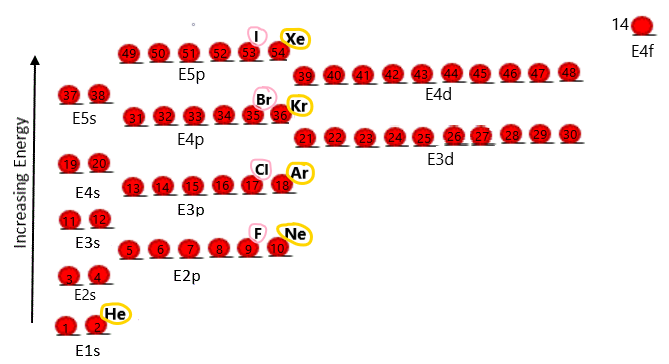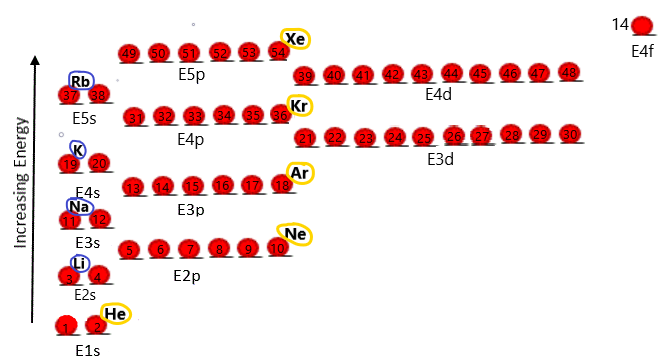There are only certain levels of energy that electrons in atoms can have. These are represented
in the Energy circles. Each Energy circle corresponds with a particular (very small) range
of energies of the electrons in that Energy circle.
Each Energy circle is associated with different shapes of orbitals that electrons move around
in. (Some of these orbital shapes are pretty crazy:
click here to see some orbital shapes!)
The different orbitals within a particular Energy circle have slightly different energies.
Another reason that atoms bond with other atoms to form molecules is because atoms "like" when the outer orbital
for electrons is full. This is the real reason that atoms "like" when their outer Energy circle is full, like we
discussed
in this unit.
(I'm bailing here; take me back to the
Atoms: Electron Organization
unit. Maybe I'll come back later, after I have a more solid understanding of atoms...)
Energy Circles
The first Energy circle (corresponding to the lowest energy levels of electrons) only
has one orbital shape, called "s" (these "s" orbitals happen to be spherical).
-
The "s" orbital can hold up to 2 electrons. The s orbital is "full" with 2 electrons.
The second Energy circle has 2 orbital shapes: the "s" (again) and the "p" orbital.
- The "s" orbital holds up to 2 electrons.
-
The "p" orbital can hold up to 6 electrons. The p orbital is "full" with 6 electrons.
- So, in total, the second Energy circle holds up to 8 electrons (2 + 6).
The third Energy circle has (maybe you guessed it?) 3 orbital shapes:
- The "s" orbital holds up to 2 electrons.
- The "p" orbital can hold up to 6 electrons. The p orbital is "full" with 6 electrons.
-
And now a "d" orbital, which can hold up to 10 electrons.
- So, in total, the third Energy circle holds up to 18 electrons (2 + 6 + 10).
The fourth Energy circle has (you guessed it!) 4 orbital shapes:
- The "s" orbital holds up to 2 electrons.
- The "p" orbital can hold up to 6 electrons. The p orbital is "full" with 6 electrons.
- The "d" orbital, which can hold up to 10 electrons.
-
And now an "f" orbital, which can hold up to 14 electrons.
- So, in total, the fourth Energy circle holds up to 32 electrons (2 + 6 + 10 + 14).
(We'll stop with this fourth Energy circle.)
The different orbitals correspond with slightly differ energies. From lowest to highest energies: s, p, d,
and f.
The element with one complete (or "full") Energy circle (the first one, #1) is helium (He), with 2 electrons
(both in the "s" orbital).
The element with two complete (or "full") Energy circles (#1 and #2) is neon (Ne), with 10 electrons
(2 in the first "s" orbital, 2 in the second "s" orbital, and 6 in the first "p" orbital).
Energy Circles (reminder)
The first Energy circle, E1, only has one orbital shape, called "s" (these "s" orbitals happen to be spherical). E1s is the lowest-energy
orbital and shown at the bottom of the figure below. (The red circles represent electrons, and the numbers inside the "electrons" indicate the order they
fill up the energy circles and orbitals: from lowest to highest energy.)
-
The "s" orbital can hold up to 2 electrons. The s orbital is "full" with 2 electrons.

E2 has 2 orbital shapes: the "s" (again) and the "p" orbital.
- The "s" orbital holds up to 2 electrons.
-
The "p" orbital can hold up to 6 electrons. The p orbital is "full" with 6 electrons.
- So, in total, the second Energy circle holds up to 8 electrons (2 + 6).
E3 has 3 orbital shapes:
- The "s" orbital holds up to 2 electrons.
- The "p" orbital can hold up to 6 electrons. The p orbital is "full" with 6 electrons.
-
And now a "d" orbital, which can hold up to 10 electrons.
- So, in total, the third Energy circle holds up to 18 electrons (2 + 6 + 10).
E4 has 4 orbital shapes:
- The "s" orbital holds up to 2 electrons.
- The "p" orbital can hold up to 6 electrons. The p orbital is "full" with 6 electrons.
- The "d" orbital, which can hold up to 10 electrons.
-
And now an "f" orbital, which can hold up to 14 electrons.
- So, in total, the fourth Energy circle holds up to 32 electrons (2 + 6 + 10 + 14).

Elements "like" it when their outer-most orbital is full. Elements lose or gain electrons to make this happen. We'll discuss three
groups of elements here: (a) Noble gases, which have full outer orbitals (and because of this do not lose or gain electrons), (b) Halogens (which
need one more electron to have a full outer orbital), and (c) alkali metals (which have to lose one electron to have a full outer orbital).
Noble gases. The elements in the last column of the periodic table are called "noble gases." Noble gases include helium, neon, and argon.
Noble gases are stable, which means they do not bond with other elements to form molecules.
This is because their outer orbitals are full. This is shown below, where the name of the noble gas is shown beside its last
electron.

Except for He (helium), which has a complete s-orbital at E1, all other noble gases have complete p-orbitals.
Halogens. The elements in the second-to-last column are called "halogens." These elements include fluorine, chlorine, and
bromine. Halogens need just one more electron to fill their outer orbitals. This is shown in the figure below, where the halogen elements
— shown beside the total number of electrons they have in their neutral state — are
circled in pink.
 Alkali metals.
Alkali metals. Elements in the first column of the periodic table (for example, lithium (Li), sodium (Na), and potassium (K), circled in blue below) are called "alkali metals." This group
of elements "like" to bond with other elements to form molecules. They do this by losing an electron (which gives them a net positive electric charge).

Since halogen elements "need" one more electron and alkali metals "want to lose" one electron, halogen elements tend to bond
with alkali metal elements to form molecules such as: LiF, NaCl, and KBr.
Hydrogen. Hydrogen is a "special" element. It only has one electron. So, it can bond with other elements to form molecules by either
gaining one electron (so that it's s-orbital is full with 2 electrons) or losing one electron. Hydrogen in our atmosphere often bonds
with another hydrogen atom by sharing their electrons so that each has 2 electrons.






 Since halogen elements "need" one more electron and alkali metals "want to lose" one electron, halogen elements tend to bond
with alkali metal elements to form molecules such as: LiF, NaCl, and KBr.
Since halogen elements "need" one more electron and alkali metals "want to lose" one electron, halogen elements tend to bond
with alkali metal elements to form molecules such as: LiF, NaCl, and KBr.